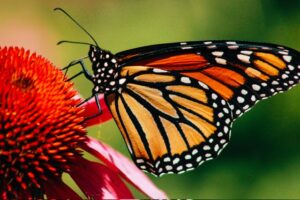Blog
Pollinator Gardens Creating a Buzz!
What Buckhorn Inn Is Doing to Protect Pollinators and Their Habitat
By Sharon Mellor
 Bees, butterflies, and other pollinators play a key role in moving pollen between flowers. Scientists estimate that one out of every three bites of our food has been created through the help of pollinators. Imagine a world without our favorite fruits, vegetables, coffee, nuts, and
Bees, butterflies, and other pollinators play a key role in moving pollen between flowers. Scientists estimate that one out of every three bites of our food has been created through the help of pollinators. Imagine a world without our favorite fruits, vegetables, coffee, nuts, and
chocolate!
Unfortunately, pollinators are facing many threats. As native plants are being replaced by nonnative
gardens, roads, lawns, and buildings, pollinators lose the food and nesting sites that are necessary for their survival. For migratory pollinators, long distances between prairies and meadows means that many will die during their journey.
While careful use of pesticides and herbicides can reduce invasive non-native species, improper use can harm wildlife, including pollinators. And finally, climate change can cause some species to starve. As temperatures warm, flowers are blooming earlier. If the blooms die before the insects who feed on those blooms arrive, many pollinators will die.
Buckhorn Inn is doing its part to protect pollinators and their habitat.
One of our new projects this fall has been to plant milkweed in several patches. Milkweed is essential for the survival of monarch butterflies. The butterflies only lay eggs on milkweed plants and the hatched caterpillars feed exclusively on the leaves of milkweed. We planted common and showy milkweed and butterfly weed this fall so that the cold temperatures and moisture will encourage spring germination. The milkweeds will grow from 2 to 5 feet tall. the star-shaped flowers will attract many pollinators with their yellow, green, purple, pink, and orange flowers. We expect to see native bees, honey bees, hummingbirds, and many types of butterflies. In the fall, the large seed pods will split open and efficiently self-sow.
We also have been experimenting to find a “low mow” schedule that works well for us. By allowing our grass to grow a bit longer and letting weed flowers like dandelions bloom, our
lawns will provide nectar and pollen to help pollinators thrive.
Hand-in-hand with these efforts, we are examining our use of pesticides, fungicides, and herbicides. In particular, widely-used neonicotinoids are absorbed by plants and can be present in pollen and nectar, making them highly toxic to bees. We will never use common brands like Sevin, Orthene, and Raid in an area where bees might feed. When we find we do need to use pesticides, we will follow recommended practice and spray them carefully on still days very early or late in the day to give them time to dry before the bees come to feed.
We also expanded our plots of native wildflowers over the summer. Our wildflower plots include black-eyed susan, blood root, beebalm, fire pink, iron weed, joe pye weed, cone flower, thistle, wild geranium, and other wildflowers native to eastern Tennessee. Our honeybee hives love them! Mariupol’s hive did produce some honey this year. Unfortunately, we had some rainy days during the prime nectar flow, so the workers hung around inside instead of foraging. We harvested about seven partial frames which resulted in about a gallon of amber goodness. We did not harvest any honey from Milan’s hive this year, but the bees appear strong going into the winter. We are planning to insulate the hives and provide them winter feed consisting of sugar and pollen patties.
Please visit us next summer and check out our bee-utiful gardens!




Gatlinburg Weather
Click for weather forecast